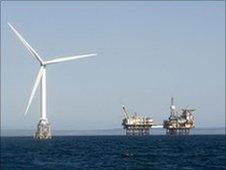Aberdeen-based SeaEnergy sells up after setback
- Published

The company is selling off its interests in three offshore wind farms
An Aberdeen-based specialist wind farm developer has said it is looking for a buyer for the main part of its business.
The move comes after directors of SeaEnergy failed to win backing for its investment strategy.
It intends to focus instead on building up a stake in the new market for offshore turbine servicing.
The company reported a pre-tax loss of £6.5m, having faced turbulence in its development of offshore wind projects.
Its share price on the Alternative Investment Market (AIM) fell sharply on the news.
The company, formerly known as Ramco, was founded in 1977 by American oilman Steve Remp, who remains executive chairman.
It gained a strong reputation in North Sea oil developments, as well as being a pioneer investor in Azerbaijan and, more recently, in Iraq.
In 2005, it suffered a major setback in an Irish offshore gas development.
That residual interest in oil includes a one-third share of the Mesopotamia Petroleum Company, which remains "deeply challenging", according to the company's annual results statement.
Pushing ahead
It has run into major funding difficulties following the breakdown of a joint venture with the state-owned Iraqi Drilling Company.
The move from North Sea oil into offshore renewable energy was only decided in September.
But the attempt to build up a presence in the fast-growing sector has not been matched by funding.
Investors have refused to back SeaEnergy's investment plans.
It has also received offers for all or part of SeaEnergy Renewables Limited (SERL), in which it has an 80% stake.
Part of its problem came from the withdrawal of RWE, owner of npower, from a joint venture in Inch Cape, a sea area off the coast of Fife, in which they had won the rights for development in the third round of licensing.
Meanwhile, it has been pushing ahead with a different, 1,300 megawatt windfarm in the Moray Firth, in which it has a 25% stake with Portuguese company EDP Renovaveis.
It has established a project office in Edinburgh and expects it to start operating from 2016.
SeaEnergy is also developing a joint venture in offshore wind in Taiwan.
Share performance
Directors have now decided that the best way forward is to seek a buyer for SeaEnergy Renewables, possibly maintaining some ownership. They are not saying how much they expect to receive for a sale.
According to the results statement, a spokesman said; "We need to reflect on our poor share price performance where we have been unable to maintain and build on the increase in market capitalisation we achieved after the UK Round 3 success.
"Shareholders are right to expect much better performance and we have listened to them. The time has therefore come to pass the SERL business to a larger company with the resources to fully exploit SERL's full potential".
SeaEnergy's attempt to focus instead on servicing the windfarm industry through the construction, installation and operational phases for wind turbines.
It believes that part of the market is undeveloped, and has a £30,000 Scottish Enterprise grant to help a team of three develop a business plan.
In its results statement, the company stated: "The economic viability of offshore wind farms is strongly influenced by the degree of accessibility to the turbines, and we have identified that an opportunity exists for the provision of vessel systems capable of offering a far higher level of access to turbines than is currently available".